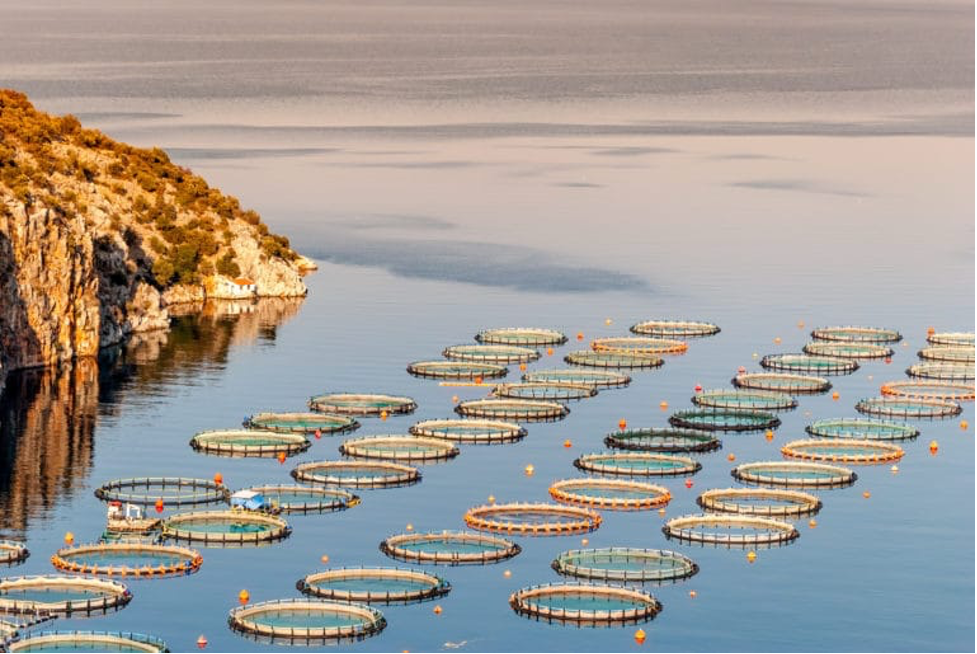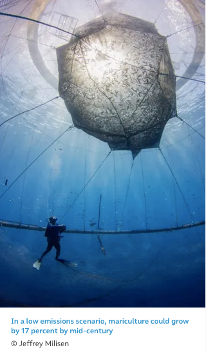
Ocean-farmed seafood or mariculture is often seen as a panacea to the problems of depleted stocks of wild fish and growing human demand and is expected to grow substantially in the coming years, says lead author Dr. Muhammed Oyinlola, a postdoctoral research fellow at UBC's Institute for the Oceans and Fisheries (IOF).
But the new modeling study highlights the industry is as vulnerable to the effects of climate change as any other. "If we continue to burn fossil fuels at our current rate, the amount of seafood such as fish or mussels able to be farmed sustainably will increase by only eight percent by 2050 and decline by 16 percent by 2090."
By comparison, in a low emissions scenario where action is taken to mitigate climate change, mariculture is projected to grow by about 17 percent by the mid-21st century and by about 33 percent by the end of the century, relative to the 2000s.
Many factors are considered for this model, including changing ocean temperatures, suitable mariculture areas in the future, and the supply of fishmeal and fish oil. It examined approximately 70 percent of the world's mariculture production as of 2015, focusing on Exclusive Economic Zones where most of the world's seafood farming occurs.
The effect of climate change on mariculture production differs depending on where farms are in the world and what they produce, says Dr. Oyinlola. The hardest-hit regions in the high-emissions scenario— Norway, Myanmar, Bangladesh, the Netherlands, and China—could decline their mariculture production by 40 to 90 percent.
Climate effects on mariculture include changes in the area of viable ocean in which to farm fish and the stock of food used to feed them. Fish farms tend to use fishmeal and fish oil, primarily composed of smaller fish such as herring and anchovy - stocks also threatened by climate change.

"Some regions produce more bivalves, such as mussels, oysters, and clams, and in these regions, the impact is smaller," Dr. Oyinlola said. "In regions that produce more finfish, such as salmon, the impact will be high due to reduction in the supply of fishmeal and fish oil."
Under current carbon emission rates, finfish farming is projected to decrease globally by 3% by 2050 and 14% by 2090. Bivalve farming is projected to increase by 2050 and decrease by 2090 under both climate scenarios.
Countries where mariculture is prominent, especially for finfish production, such as Norway, Iceland, Finland, Chile, and Bangladesh, will be hit hardest, according to Dr. Oyinlola. In contrast, regions that produce more bivalves will be more stable or, in Canada's case, will grow.
Vegetarian fish: feeding fish soybeans
The study also found that substituting fishmeal and fish oil for plant-based foods such as soybeans could help alleviate the effects of climate change on fish farms.
When a quarter of the fish food was substituted with alternatives, mariculture production was projected to increase 25 percent by 2050 and 31 percent by 2090 under a low emissions scenario.
With no change to current emissions, mariculture production was projected to increase by 15 percent by 2050 and 4 percent by 2090 when a quarter of the fish food was substituted with alternatives. These percentages increased when half the food was substituted in both climate scenarios.
"This study highlights the need to diversify mariculture development from the current focus on fish," said senior author Dr. William Cheung, IOF professor and director. Climate-adapted mariculture would include species not dependent on fishmeal and fish oil, such as shellfish or algae, or those that can utilize non-fish-based feed. "Farming these species generally helps to reduce exposure of seafood farming to climate hazards."
While there is enthusiasm about ocean mariculture helping to increase the production of seafood, the study shows if humans don’t relieve climate change, such enthusiasm will be tempered, says Dr. Cheung. “Climate change affects everything, including aspects of seafood farming we’ve not previously considered. We need to act, and quickly, to mitigate climate change rather than rely on one solution to solve all our seafood production problems.”
